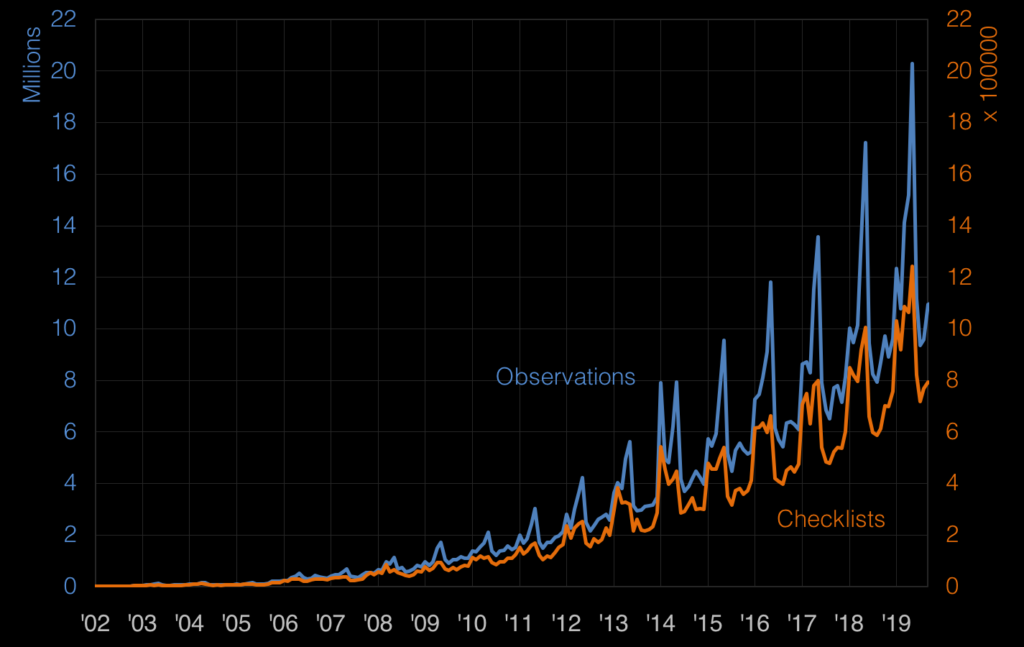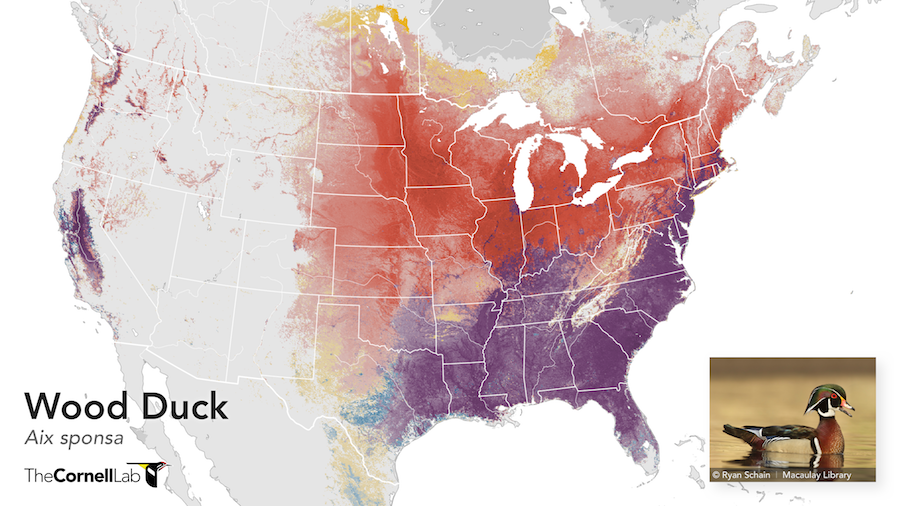17 years ago, we started an experiment: using the internet to connect birdwatchers around the world in a way that informs research and conservation. With every year that goes by, we’re awed by the passion and drive of the community that continues to power this experiment. There are now more than 500,000 eBirders who have contributed sightings from out their windows, on the way to work, or at visits to parks, ponds, and fields. eBirders have collected more than 737 million bird observations, continuing to make eBird the world’s largest biodiversity-related citizen science project. Everything you do makes a difference, from inspiring the millions who come to eBird to learn, to sharing your bird observations for the tens of thousands of people who use eBird data every year for research, conservation, and education.
2019 was a milestone year for eBird, delivering a new era of scientific and conservation applications, innovative new birding tools, and much more. Of course, as always, all of this is 100% free of charge to anyone who wishes to use it. We appreciate and thank our eBird Supporters who help support eBird by making a monthly contribution. Here’s what made our list of what we will remember from 2019.
Science and Conservation
- 2019 featured the first annual update of eBird Status and Trends, which now provides status and distribution information for 302 species. Trends and additional species will be coming in the first half of 2020. These results are the culmination of eBird’s initial vision of connecting birders around the world in a way that informs research and conservation. Explore more.
- Researchers published 58 peer-reviewed publications this year incorporating eBird data, bringing the total number of peer-reviewed publications using eBird data to over 300. See all eBird publications here.
- eBird data downloads are updated monthly and continue to be a free resource that is accessible via the Data Download page. More than 100,000 people downloaded raw eBird data for analysis and more than 5,200,000 people visited the eBird website in 2019.
New Birding Tools
- 2019 brought us mobile-friendly versions of Species Maps, the Hotspot map, checklist pages and Alerts, allowing you to easily browse more eBird tools while on the go.
- The optimized media upload process launched in September 2019, allowing you to more-easily upload your photos and sounds to your eBird checklists. In addition, this new media process has paved the way for Merlin Photo ID integration in eBird—stay tuned for more info on that in the coming months!
- eBird Mobile was used to collect more than 6.2 million eBird checklists in 2019. Our big focus for mobile development this year was reworking the app for more efficient eBirding around the world, regardless of data connection. eBird 2.0 was released on Android and is coming to iOS in early 2020. Stay tuned in 2020 for Explore Data tools in eBird Mobile.
- Merlin Bird ID has expanded to cover more than 5,000 species, with recent updates adding packs for Australia, Asia, and more of South America and Europe. New range maps have been added for many species, and the eBird Life List integration helps you find new birds for your life list, wherever you are traveling. Watch for packs covering more of Africa and Asia in 2020!
eBird Essentials
- In 2018, with help from professional educators at the Cornell Lab of Ornithology, we launched the eBird Essentials course. In 2019, we continued to update the course, which has now been taken by more than 21,000 eBirders. The course takes an hour or so and has short videos, questions, and quizzes to make sure you learn key concepts. Our hope is that everyone who submits to eBird or is curious about the project gives it a try. Maximize the value of your sightings by learning about the best practices for submitting your observations. Learn how your daily observations contribute to other birders, science, and conservation. Try eBird Essentials today!
eBird Team and Partner Expansion
- Thanks to the generosity of ZEISS, we were able to award more than 15 eBirders free binoculars in 2019. We are excited to continue our eBirder of the Month awards in 2020 to thank our eBird community for their commitment to submit observations. In 2020, will you win free ZEISS binoculars?
- We launched three new eBird portals in 2019: the New Zealand Bird Atlas, the New York Breeding Bird Atlas III, and the Maryland & DC Breeding Bird Atlas 3. The New Zealand Bird Atlas is a collaborative project that includes Birds New Zealand, Goodness Kitchen, and Wildlife Management International Limited. For the New York Breeding Bird Atlas III, we’ve been fortunate to work with the New York Natural Heritage Program, New York State Department of Environmental Conservation, New York State Ornithological Association, New York Cooperative Fish and Wildlife Research Unit, Audubon New York, and the State University of New York College of Environmental Science and Forestry. And in the Maryland & DC Breeding Bird Atlas 3 the key partners have been the Maryland Ornithological Society and the Maryland Department of Natural Resources. We’ll also be launching eBird Rwanda in January 2020—stay tuned for more there soon!
2019 eBird Growth

eBird growth in 2019
- 737 million bird sightings have now been entered into eBird. This includes more than 140 million in 2019 alone; with 20,286,678 sightings from just the month of May 2019. This is more than 27,200 bird observations every hour in May, 24 hours a day—all month. eBird’s contributions make up more than 40% of the biodiversity data in the Global Biodiversity Information Facility (GBIF). See the eBird GBIF dataset here.
- The fifth Global Big Day and second October Big Day set new heights for big days in birding. On 4 May 2019, 35,000 birders collectively noted 6,955 species of birds, reporting 91,000 checklists from 174 countries. Mark your calendar for next year’s Global Big Day: 9 May 2020.
- eBirders uploaded more than 4.7 million photos and 135,000 sounds to the Macaulay Library with their eBird checklists in 2019—like the Spoon-billed Sandpiper by Lefei Han at the top of the post, which was the #1 community-rated image in eBird and the Macaulay Library in 2019.
- New translations continue to support 11 languages throughout eBird.org (27 on eBird mobile) as well as more 63 languages and regional versions of bird common names. See a full list of our eBird Common Names here.
It has been an inspiring year with some huge steps for eBird, and we can’t wait to see what we can continue to build together with you in 2020.


